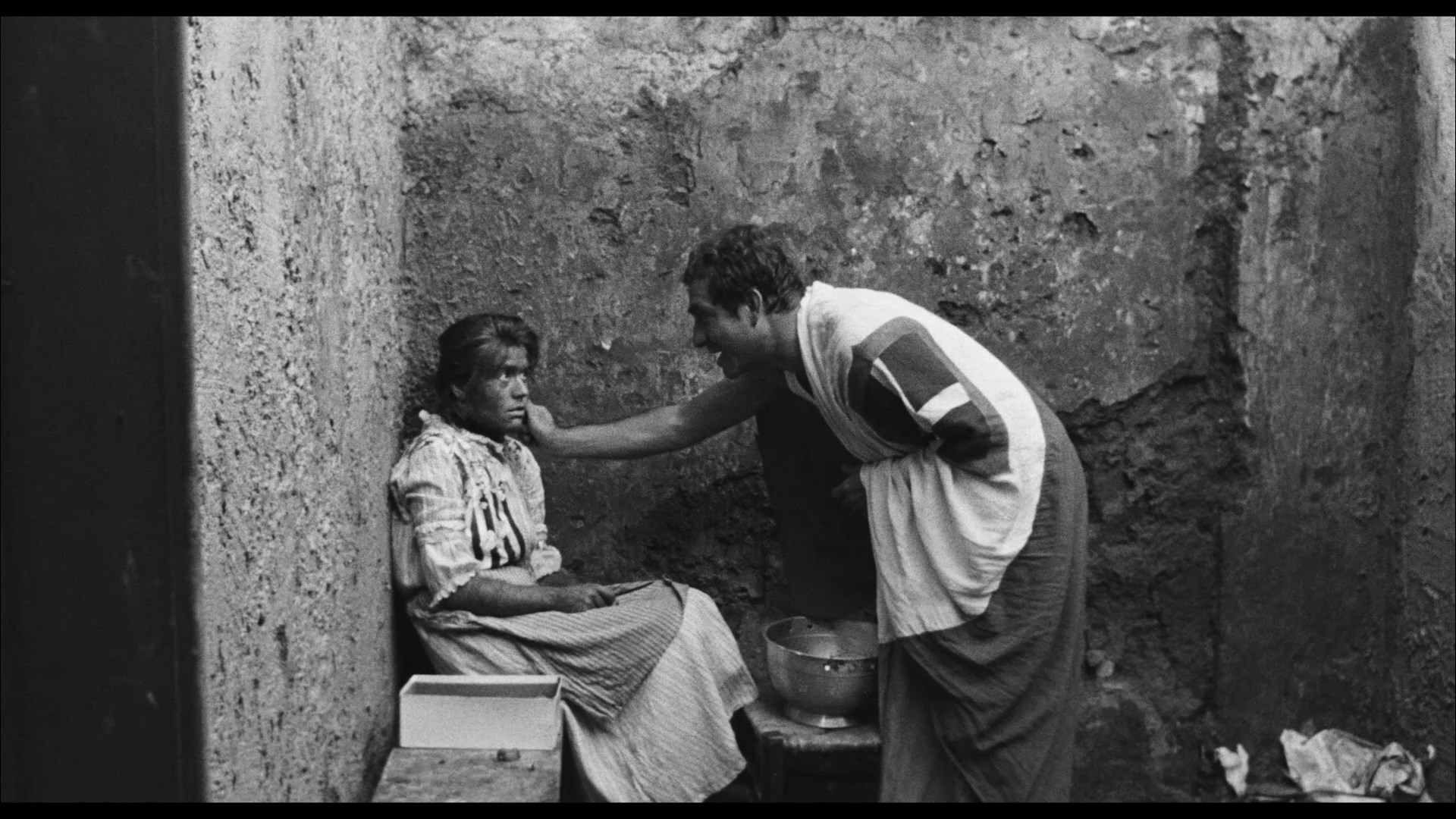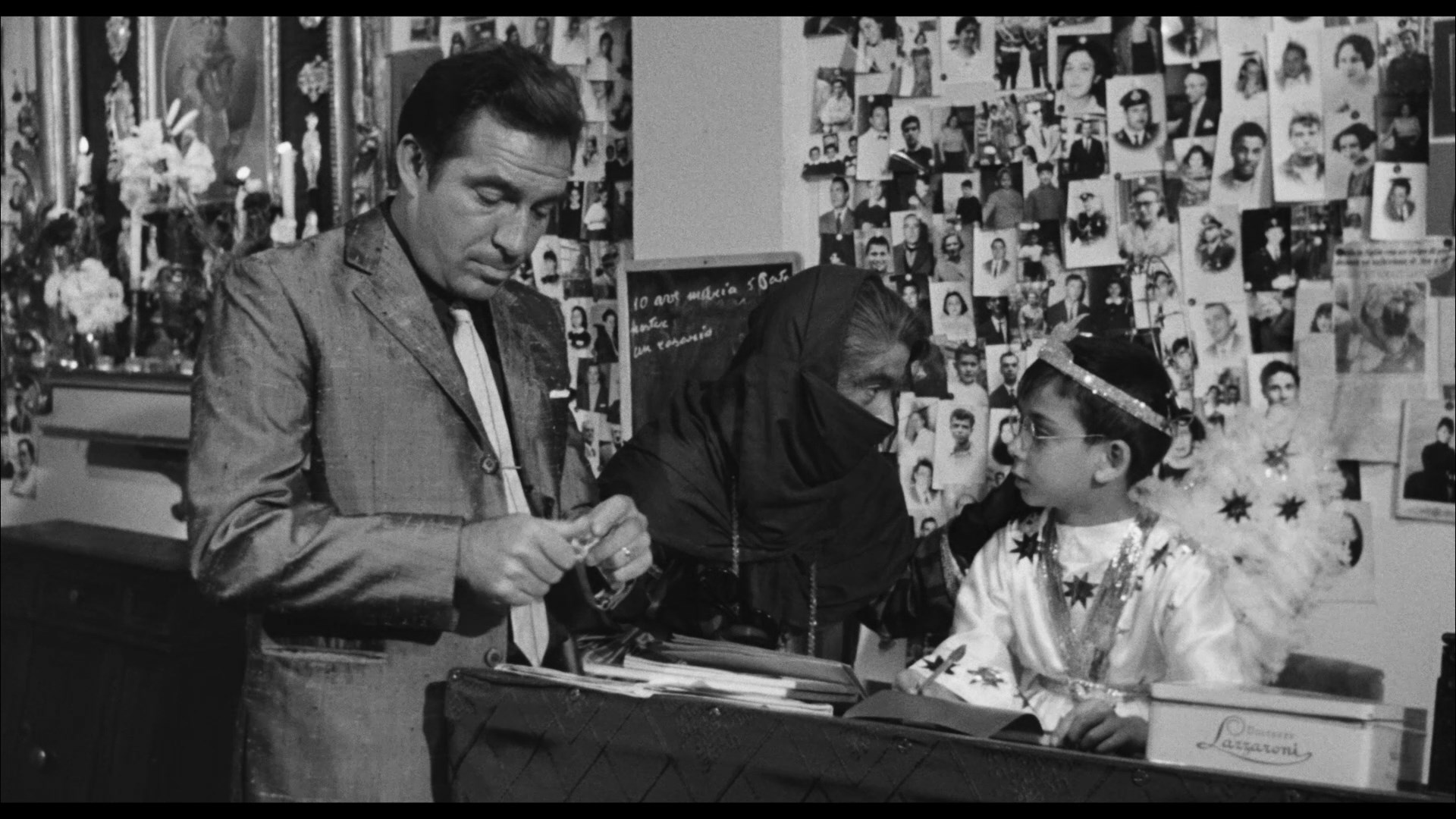
B&W, 1964, 94 mins. 3 ses. / 98 mins. 24 secs..
Directed by Marco Ferreri
Starring Ugo Tognazzi, Annie Girardot, Achille Majeroni, Filippo Pompa Marcelli
Cult Films (Blu-ray) (UK R0 HD) / WS (1.85:1) (16:9), Surf (DVD) (Italy R2 PAL)
One  of the biggest names in Italian cinema throughout the '60s and '70s,
of the biggest names in Italian cinema throughout the '60s and '70s,  producer Carlo Ponti was best known for propelling his wife Sophia Loren to fame but also served as a driving force behind many major works by French and Italian filmmakers ranging from Jean-Pierre Melville to Agnès Varda and Jean-Luc Godard. One of his early discoveries was director Marco Ferreri, who had helmed four features that earned positive notices but little international attention starting in the late '50s. Together they caused a considerable amount of attention with The Ape Woman, a potent satirical tragedy inspired by the real-life story of Julia Pastrana, a hair-covered woman who was ruthlessly exploited in Mexico in the 1800s. Here the concept gets transposed to modern Italy, with a carnivalesque atmosphere that was likely chosen to appeal to the international appetite for all things Federico Fellini. This is total Ferreri to the core though, especially in his original cut that was considerably altered with an entirely different ending for its presentation at Cannes (where it competed for the Palme d'Or). The film was given a modest U.S. release by Embassy Pictures in the modified happier version (complete with coverage in Famous Monsters of Filmland), after which it largely slipped into obscurity except for die-hard Ferreri fans and those lucky enough to snag its brief dubbed VHS edition from Something Weird as perhaps the classiest entry in "Frank Henenlotter's Sexy Shockers from the Vault."
producer Carlo Ponti was best known for propelling his wife Sophia Loren to fame but also served as a driving force behind many major works by French and Italian filmmakers ranging from Jean-Pierre Melville to Agnès Varda and Jean-Luc Godard. One of his early discoveries was director Marco Ferreri, who had helmed four features that earned positive notices but little international attention starting in the late '50s. Together they caused a considerable amount of attention with The Ape Woman, a potent satirical tragedy inspired by the real-life story of Julia Pastrana, a hair-covered woman who was ruthlessly exploited in Mexico in the 1800s. Here the concept gets transposed to modern Italy, with a carnivalesque atmosphere that was likely chosen to appeal to the international appetite for all things Federico Fellini. This is total Ferreri to the core though, especially in his original cut that was considerably altered with an entirely different ending for its presentation at Cannes (where it competed for the Palme d'Or). The film was given a modest U.S. release by Embassy Pictures in the modified happier version (complete with coverage in Famous Monsters of Filmland), after which it largely slipped into obscurity except for die-hard Ferreri fans and those lucky enough to snag its brief dubbed VHS edition from Something Weird as perhaps the classiest entry in "Frank Henenlotter's Sexy Shockers from the Vault."  Meanwhile Ferreri would go on to a successful career in Europe (but with little attention in the U.S.)
Meanwhile Ferreri would go on to a successful career in Europe (but with little attention in the U.S.)  thanks to films like La Grande Bouffe, Liza, The Last Woman (where's that Blu-ray?), Bye Bye Monkey, and Tales of Ordinary Madness. Fortunately The Ape Woman has finally been fully restored with both versions available to view for comparison, which should be an eye-opening experience for anyone interested in Italian cinema or one of its most talented and outrageous provocateurs.
thanks to films like La Grande Bouffe, Liza, The Last Woman (where's that Blu-ray?), Bye Bye Monkey, and Tales of Ordinary Madness. Fortunately The Ape Woman has finally been fully restored with both versions available to view for comparison, which should be an eye-opening experience for anyone interested in Italian cinema or one of its most talented and outrageous provocateurs.
While visiting a Catholic poorhouse overseen by nuns to do a presentation on missionaries, huckster Antonio (Tognazzi) is fascinated by the hair-covered Maria (Girardot), who works as a kitchen servant and is deeply ashamed of her appearance. He smooth talks her into coming along with him ("You're lucky you met a genius like me"), passing himself off as a great artist and entrepreneur. In a slum warehouse he mounts a production exploiting his discovery, refining his pitch to get locals to watch him do shows passing her off as a freakish discovery from Africa. They settle into a peculiar sort of domestic life together that culminates in their marriage (purely for opportunistic purposes) and a saucier version of their show exported to Paris where Antonio has to deal with the implications of his actions.
 Exactly how this situation plays out differs greatly depending which version
Exactly how this situation plays out differs greatly depending which version  you watch, though both endings are actually quite effective and make their points about society's treatment of outsiders in different ways. Watching them in tandem is a bit like a proto-Sliding Doors experience as we see our couple go down two extremely separate paths, one deeply tragic and cynical while the other makes a biting point about social expectations of normal behavior versus what gets glorified for popular attention. Tognazzi and Girardot are both great here; the former anchors virtually every scene in the film, while Girardot gets the most poignant material and wrings a great deal of sympathy with even a simple tear. Ferreri's previous experience with both comedy and earthy drama come in handy here as he juggles both, capturing the dustier outlying lower classes of Italy contrasted with the glossier but sleazy strip circuit in France. It's a highly memorable film no matter what you think of it, and essential to see in both incarnations for full appreciation of its peculiar impact.
you watch, though both endings are actually quite effective and make their points about society's treatment of outsiders in different ways. Watching them in tandem is a bit like a proto-Sliding Doors experience as we see our couple go down two extremely separate paths, one deeply tragic and cynical while the other makes a biting point about social expectations of normal behavior versus what gets glorified for popular attention. Tognazzi and Girardot are both great here; the former anchors virtually every scene in the film, while Girardot gets the most poignant material and wrings a great deal of sympathy with even a simple tear. Ferreri's previous experience with both comedy and earthy drama come in handy here as he juggles both, capturing the dustier outlying lower classes of Italy contrasted with the glossier but sleazy strip circuit in France. It's a highly memorable film no matter what you think of it, and essential to see in both incarnations for full appreciation of its peculiar impact.
Home video releases of this one have been few and far between, including that VHS mentioned above and a rough-looking, Italian-only DVD from Surf in 2008. In 2021, U.K. label Cult Films gave this film its global Blu-ray debut in a pristine edition that easily makes for the best presentation of this film ever seen on home video. The transfer comes from a 4K restoration from 2017 by L'Immagine  Ritrovata from a first-generation interpositive preserved by TF1. Fortunately this is a black-and-white film so you don't have to worry about L'Immagine Ritrovata's notoriously
Ritrovata from a first-generation interpositive preserved by TF1. Fortunately this is a black-and-white film so you don't have to worry about L'Immagine Ritrovata's notoriously  dubious approach to color timing; it looks wonderful here from start to finish regardless of which version you choose to watch. The LPCM Italian 2.0 mono audio sounds immaculate here and features optional yellow English or English SDH subtitles. The sole extra here is the very welcome feature-length Marco Ferreri: The Director Who Came from the Future (98m49s), an extensive documentary featuring copious interview and behind-the-scenes footage of the filmmaker himself (talking about his films being a "punch in the stomach" to the audience, among many other things), with other participants including Gerard Depardieu, Philippe Noiret, Christopher Lambert, Ornella Muti, Sabine Ferilli, Michele Placido, and Nicoletta Braschi. If you ever wanted to see what Ferreri's personality was like or what other actors thought about the productive "anarchy" of his sets, this is a great place to start.
dubious approach to color timing; it looks wonderful here from start to finish regardless of which version you choose to watch. The LPCM Italian 2.0 mono audio sounds immaculate here and features optional yellow English or English SDH subtitles. The sole extra here is the very welcome feature-length Marco Ferreri: The Director Who Came from the Future (98m49s), an extensive documentary featuring copious interview and behind-the-scenes footage of the filmmaker himself (talking about his films being a "punch in the stomach" to the audience, among many other things), with other participants including Gerard Depardieu, Philippe Noiret, Christopher Lambert, Ornella Muti, Sabine Ferilli, Michele Placido, and Nicoletta Braschi. If you ever wanted to see what Ferreri's personality was like or what other actors thought about the productive "anarchy" of his sets, this is a great place to start.
Reviewed on October 9, 2021
![]()